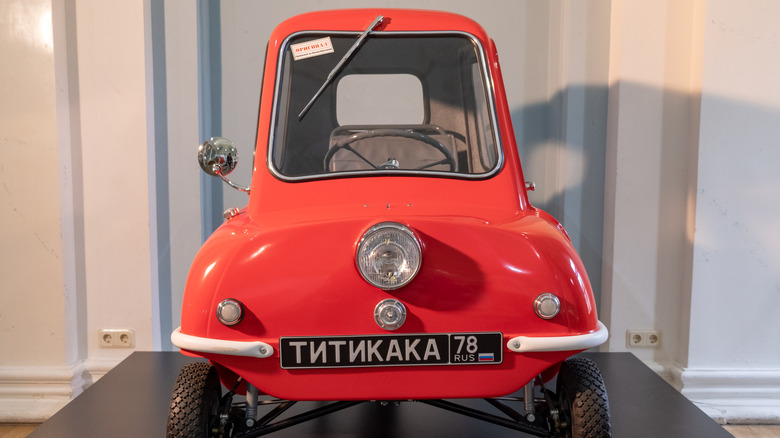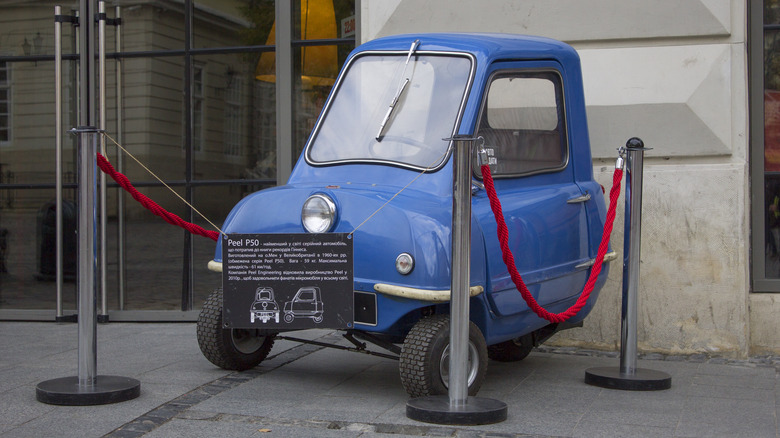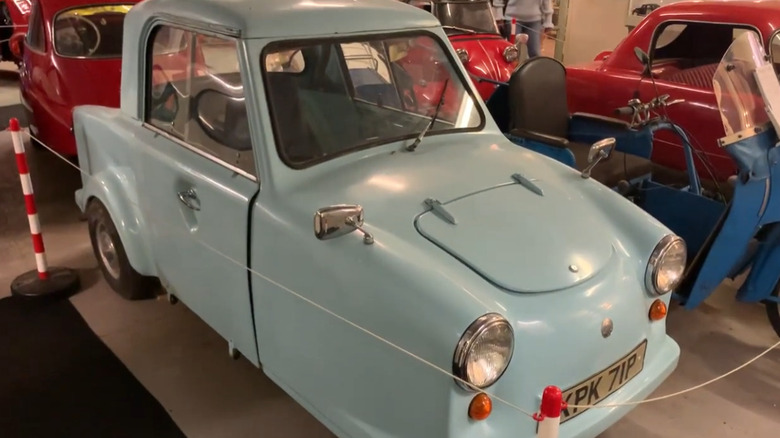5 Wacky One-Seater Cars That Are Street Legal
Typically, when you buy or lease a new car, it comes with the assumption that you'll occasionally be ferrying around friends or family members with you. Most cars have at least two seats so you can bring at least one passenger along with you, whether it's on a lengthy vacation or just a brief run to the market. However, on occasion, a car is born that eschews this design tradition, axing every last seat aside from the vital driver's seat.
Often, solo-seaters are the territory of professional racing vehicles or imaginative concept cars, vehicles like the Mclaren Solus GT, which is definitely not street legal. Sometimes, though, whether in pursuit of a truly one-of-a-kind design or just for the heck of it, a manufacturer will release a street legal single-seater car that you could, at least in theory, obtain to drive. We say "in theory" because these vehicles are very few and far between, and some have actually become exceptionally valuable collector's items.
Starting exceptionally small with the Peel P50
While small smart cars became more prominent in the public consciousness of the United States in the late 2000s, manufacturers have actually been tinkering with the concept of the "microcar" for decades. While the idea has never quite taken off, there is merit to the notion of an extremely compact car if you're only ever driving by yourself. One of the most prominent examples of retro microcars is the Peel P50.
Created by Peel Engineering in 1962, the P50 was a spunky little three-wheeler, billed as being just large enough to fit its driver and a single shopping bag. Its max speed was only about 38 mph, but it did get around 100 miles per gallon and only cost 199 pounds — about $5,800 in today's dollars — so it was surprisingly economical. Thanks in no small part to an exceptionally silly appearance on the BBC's "Top Gear," in which a 6-foot-5 broadcaster jammed himself into a P50 and drove it through the Beeb's offices, the car is worth big money today; one sold in 2016 for $176,000.
Feel like Tron on the Carver Cargo
Remember the Light Cycles in the 1982 film "Tron?" Riders would be enclosed in a canopy in these narrow, futuristic vehicles, turning on a dime in an effort to destroy enemy bikes with a light ribbon. It's a classic sci-fi aesthetic, and while we have no hard proof to imply this, we like to think there's a "Tron" fan among the designers of the Carver Cargo, developed by Cargo Electric.
While the Carver Cargo — 9,990 pounds, or $13,045 plus tax — looks like a trike, it's got a full automobile interface underneath its canopy, including a full seat, pedals, and a steering wheel. Since it's a cargo vehicle, it's obviously not as fast as a Light Cycle, but it can go up to 28 mph while carrying up to 500 liters (or roughly 1,100 pounds) of cargo in its rear compartment, and an extra 100 liters behind the driver's seat. The really cool part of the Carver Cargo is that, as the driver makes turns, a hydraulic ram in the back of the vehicle causes the entire cockpit to tilt, leaning into corners like a racing motorcycle. If you want the vibe of being a high-speed biker but prefer the comforts and storage capacity of a car, the Carver Cargo is for you.
Ride next to your engine in the MEV Atomic
Kit cars are another major stomping ground for single-seater designs. If you're building an entire car from scratch, after all, it's naturally going to be a bit easier to leave all the extra seats out and focus on the driver's seat. It's your kit car, so you'll probably be the only one driving it anyway. One example of a single-seater kit car is Exomotive's MEV Atomic, and despite looking like an oversized go-kart, it was in fact road legal, provided you remembered to add a seatbelt when you built it.
In its assembled state, the MEV Atomic was a fearsome road warrior, packed with a 998cc power plant generating 150 horsepower at the bare minimum. With the installation of an R1 turbo kit, that power potential increases to a terrifying 235 horsepower. One of the most distinctive aspects of this kit car is that the engine was seated right next to the driver, where the passenger seat would be, so if you really opened it up, you'd be in for quite the cacophony in your left ear.
The Atomic's base kit cost $9,523. You'll have to get yours used, though; Exomotive stopped distributing the kits in 2013.
Redefine drag racing with the Dodge Challenger SRT Demon 170
One of the most legendary vehicles in terms of raw muscular output is the classic Dodge Challenger, a car rivaled only by Dodge's own Charger for top speed and acceleration. The Challenger was discontinued in 2023, but before it went out for good, it received an offshoot to ensure it went out with a bang: the Challenger SRT Demon 170. Released in May of 2023, just a scant few months before the Challenger's swan song, the Demon 170 was exactly what its name implied — a speed demon.
The Demon 170 was technically street-legal, but if you owned one, you probably weren't using it for a trip to the park. This car was built first and foremost as a drag racer, going from zero to 60 mph in just 1.66 seconds and boasting 1,025 total horsepower at 6,500 rpm. According to Dodge, the Demon 170 was the world's first eight-second factory muscle car, clearing a quarter mile in 8.9 seconds at 151 mph and change.
None of this came cheap; you can buy one used for about $250,000. Interestingly, while the basic Demon 170 package was a single-seater, you could actually pay a separate fee to have a passenger and rear seats installed, though that kind of speed might not be a great idea for a family road trip.
The AC Model 70: Made for Injured WWII Veterans
Not all single-seater cars are meant to be speedy or loaded with gimmicks. Some are designed to serve a common good, provide a much-needed service to those who may not be able to drive a car unassisted. This was the philosophy behind the AC Model 70, a car built by Britain's AC Cars with the cooperation of the British Ministry of Pensions following the end of World War II.
The Model 70, known as an Invacar, was designed to assist the many returning military veterans of the war whose motor skills were damaged in combat and who couldn't operate a normal car. You couldn't buy one; they were leased out directly by the British government.
The Model 70 was designed to accommodate various kinds of disabilities with features like adjustable controls and seats, with wheelchair users a particular focus. They were manufactured from 1947 until 1976. Government support was withdrawn for the Model 70 in 2003, and they were supposed to have been destroyed, but there are those who contend that they are street legal if purchased from private collectors.


